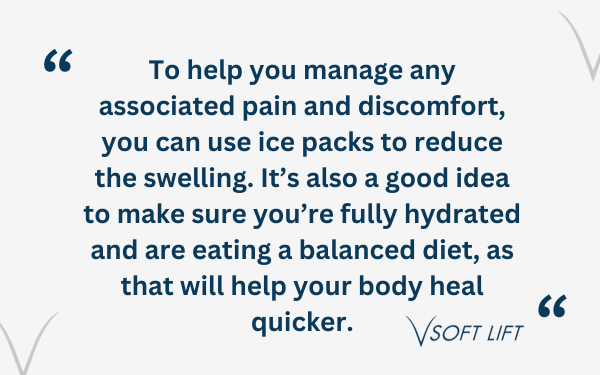
Cosmetic medicine is experiencing a surge in popularity, thanks in large part to the many new anti-aging treatments that have hit the market in recent years. Today, patients can address many of the common signs of aging without having to undergo expensive and invasive surgery.
PDO thread treatments have risen to the top of the list for many patients, due to the amazing results they can produce in a minimally-invasive way. Without undergoing surgery, a patient can address fine lines and wrinkles, drooping or sagging skin, and lack of definition in their face.
The procedures only take about an hour to complete, and patients can resume most of their day-to-day activities as soon as they leave the office.
There is a much shorter downtime and less serious recovery period following PDO threads than other treatments, with most patients experiencing minor bruising and/or swelling following a treatment.
In this article, we’ll discuss aftercare for PDO threads treatments, and how to manage pain and discomfort.
To help you manage any associated pain and discomfort, you can use ice packs to reduce the swelling. It’s also a good idea to make sure you’re fully hydrated and are eating a balanced diet, as that will help your body heal quicker.
 Medically reviewed by: Elizabeth Williams RN
Medically reviewed by: Elizabeth Williams RN
Updated: 7/31/2025
Are PDO Thread Treatments Painful?
PDO thread treatments are generally not considered to be a painful procedure. Unlike surgery, only local anesthesia is needed to perform the treatment.
Once the treatment area is sufficiently numb, your practitioner will insert the threads into your face using a preloaded cannula, which is similar to how an IV line is inserted. They will then ensure the threads are positioned correctly and snip off any excess threads before the procedure is over.
While this is happening, you may feel slight tugging or pressure, but you shouldn’t feel any pain. As mentioned, you will then be able to leave the office once the treatment is over and resume most of your daily activities.
The practitioner will provide you with a list of after-care instructions to ensure proper healing, which includes avoiding strenuous activities and deep facial massages or cleansing for a few weeks.

How Can You Manage Pain and Discomfort After PDO Threads?
In the days after a PDO thread treatment, most people will experience minor swelling and/or bruising. This is a typical way that your body will start to respond to having a foreign object inserted into it.
What your body is doing is starting the healing process, which over time will break down the PDO threads and fully absorb them into the body. As it does so, it will produce extra collagen in the treatment area, which also extends the life of the PDO threads as well as makes your skin more elastic, shiny and youthful-looking.
In most cases, the swelling or bruising you experience shouldn’t be too severe. In fact, it will usually resolve itself within about a week on its own.
To help you manage any associated pain and discomfort, you can use ice packs to reduce the swelling. It’s also a good idea to make sure you’re fully hydrated and are eating a balanced diet, as that will help your body heal quicker.
There are some over-the-counter medications that you can take after a PDO threads treatment, but make sure that you are consulting with your practitioner first and following their post-care instructions.
That’s because you shouldn’t take any medication containing aspirin or any NSAIDs such as ibuprofen or naproxen for a few weeks after a PDO threads treatment. These medications can actually get in the way of the healing process, which is something you definitely don’t want following your procedure.
If you are experiencing any major pain and discomfort, or if the minor swelling and bruising persists for more than a few weeks, you should consult your practitioner to see if there’s anything else you need to do.
| Timeframe | Expected Effects | Recommended Actions |
|---|---|---|
| Immediately After Procedure | Mild swelling, slight bruising, tightness | Apply cold compress for 15–20 minutes at a time; avoid touching or massaging the area. |
| Day 1–2 | Continued swelling, mild soreness or pressure | Rest, stay hydrated, sleep on your back with head elevated. Avoid NSAIDs unless advised. |
| Day 3–5 | Bruising may appear or peak, discomfort fading | Use ice packs as needed. Avoid strenuous activities and facial movements. |
| Week 1 | Swelling and bruising start resolving | Return to normal skincare (light touch only). Continue to avoid massages and saunas. |
| Week 2+ | Most symptoms gone, collagen stimulation continues | Resume most activities. Monitor for unusual discomfort and follow up if needed. |
Uses High-Quality PDO Threads from V Soft Lift
Most patients will experience only minor swelling and/or bruising following a PDO threads treatment. Often, this will resolve itself within about a week, but you can use ice packs and take certain over-the-counter medications to help manage the pain and discomfort.
Should you be experiencing extreme pain, make sure to contact your practitioner right away.
Choosing a reputable provider is key to getting the best results from PDO threads in the safest way possible. So, is choosing a provider who uses high-quality threads such as those produced by V Soft Lift.
Our PDO threads are engineered to be comfortable, strong and dissolve slowly over time, producing the best results possible with minimal side effects.
For more information, contact us today.
